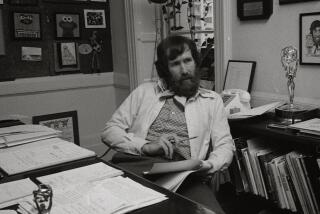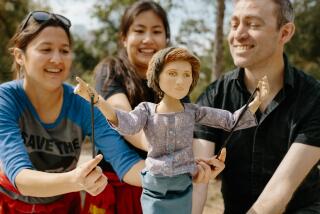Richard Brandon; Partner in Yale Puppeteers
- Share via
Richard Brandon, the youngest of the three Yale Puppeteers, has become the first to die.
He was 80 when he died May 4 at Turnabout House in Hollywood, the home the three men had occupied for the last several years and named after the Turnabout Theatre that they made nationally famous for 15 years.
Brandon, said fellow Yale Puppeteer Forman Brown, had returned home from the hospital to die after refusing kidney dialysis treatments.
Joined as Students
Brown and the third puppeteer, Harry Burnett, met while both were students at the University of Michigan, providing author and critic John Mason Brown with this line now etched in Turnabout lore:
“They’re called (Turnabout) Yale Puppeteers because they came from the University of Michigan.”
Burnett eventually did go to Yale, where he encountered Brandon, a fellow student and marionette enthusiast. Brown later joined them there and in 1928 the Yale Puppeteers were born, three starving students who designed their own dolls, wrote lyrics and songs for them and toured New England in a truck they dubbed Camille (“because she died so beautifully.”)
The three moved to Los Angeles in 1929 and opened their puppet show in a club in Beachwood Canyon where such silent screen stars as Theda Bara and Colleen Moore saw their act and returned with their friends. Another regular was evangelist Aimee Semple McPherson.
A New Location
Neighbors complained about the racket that accompanied the Hollywood crowd, and the puppeteers moved to Olvera Street to an 80-seat theater where all the tickets were $1.
Brown concentrated on composing the silly songs that added to their fame, while Burnett designed new puppets and Brandon became the business manager and financier. To that theater went Charlie Chaplin, Gloria Swanson, John Barrymore and Albert Einstein, who was then teaching at Caltech.
(Brandon did occasionally get to pull a puppet’s strings, Burnett once recalled, but “he had no sense of rhythm.”)
After nearly two years at the Teatro Torrito (where the stage screen featured the backside of a bull rather than his head because the artist who painted it was no good at faces), the Yale Puppeteers returned to the East Coast and in 1931 opened on Broadway.
Specialty in Spoofs
There, before audiences that included Marie Dressler from films and Fritz Kreisler from the music world, they put on such spoofs as “Mister Noah” and “The Pie-Eyed Piper.”
The Depression curtailed audiences, and Brandon, Brown and Burnett were glad to return to Hollywood when offered a part in a Fox Studio film called “I Am Suzanne.” But after that, they returned to New York for a spot in a hotel musical revue where their salary was only their room and board at the hotel.
That experience, the three men recalled in a 1981 interview with The Times, whetted their appetite for their own theater, which they envisioned as a “turnabout” house: a puppet stage at one end and a stage for live entertainers at the other.
On July 10, 1941, the Turnabout Theatre opened at 716 N. La Cienega Blvd. in Hollywood after 70 old Pacific Electric streetcar seats were purchased at $3.50 each. After the puppeteers had performed, the seats would be switched around so audiences could catch the legendary performances of Elsa Lanchester and others on the stage at the far end of the room.
‘Like the Dodgers’
The Turnabout, which eventually was expanded to 180 seats, quickly became one of the leading theatrical attractions in the city.
“We were like the Dodgers,” Brandon said in 1981. “We started at a dollar and the most we ever charged was $5 or $7 on New Year’s Eve.” That, he added, included a meal.
The Turnabout produced a series of two dozen plays and revues over the years, most written by Brown and titled “Gullible’s Travels” or “Caesar Julius” and others keeping with the satiric Turnabout tradition.
More than 500,000 people were lured to the theater until 1956, when Brandon and his partners, now both 84, moved to San Francisco. The popularity of television and limited parking on La Cienega dictated the shift.
But things there were not much better, and they eventually returned to Los Angeles and found Turnabout House, which they turned into a carpenter shop for new puppets while occasionally staging casual shows for old friends.
Brandon is survived by a sister, Priscilla Rhodehamel, and, of course, his partners.
More to Read
The biggest entertainment stories
Get our big stories about Hollywood, film, television, music, arts, culture and more right in your inbox as soon as they publish.
You may occasionally receive promotional content from the Los Angeles Times.










